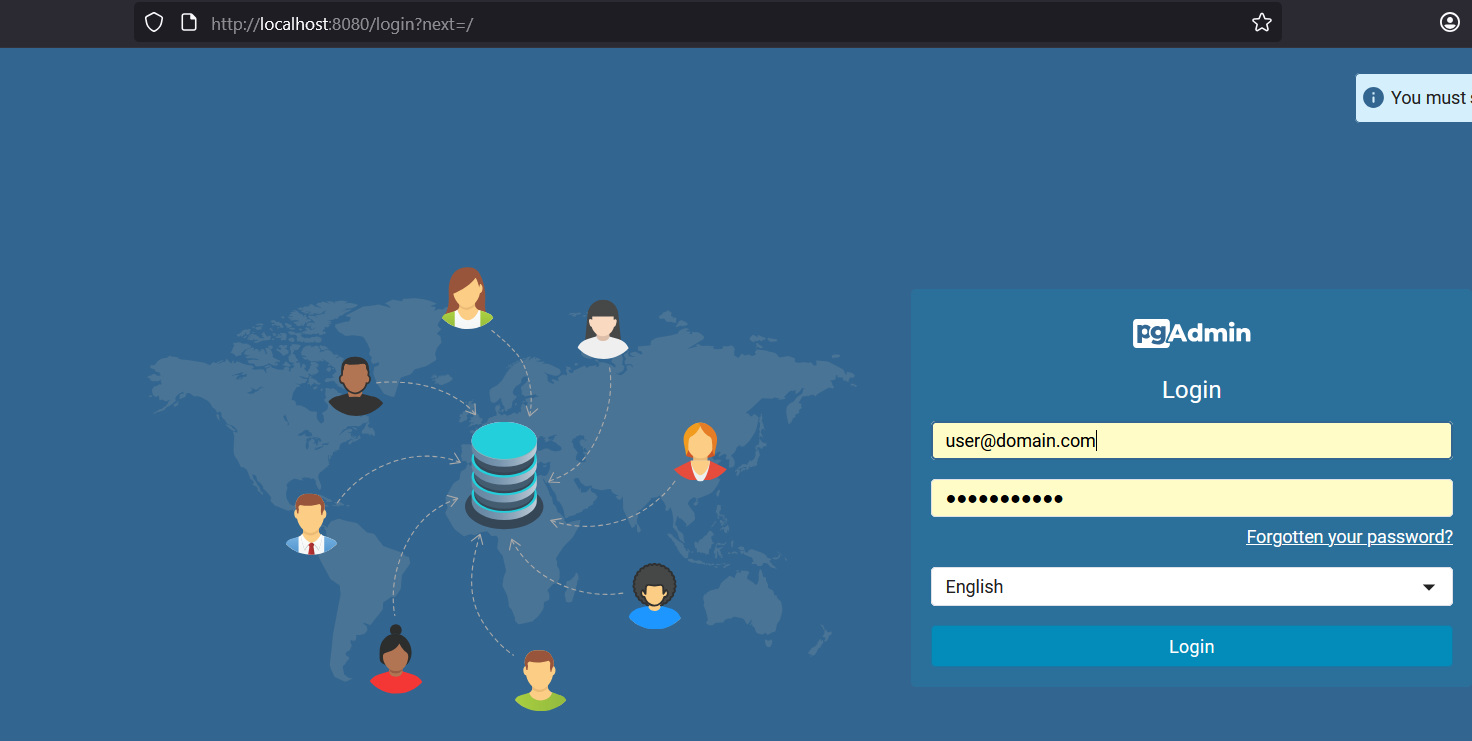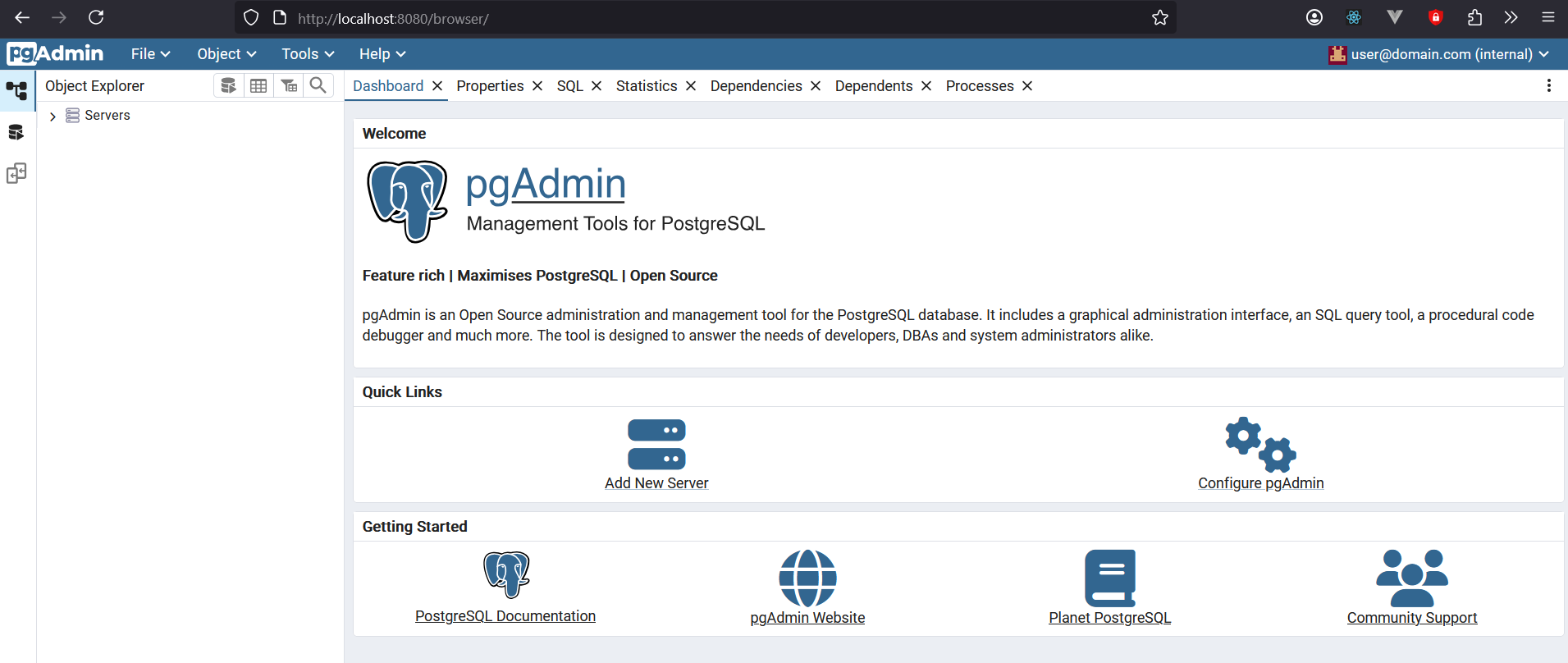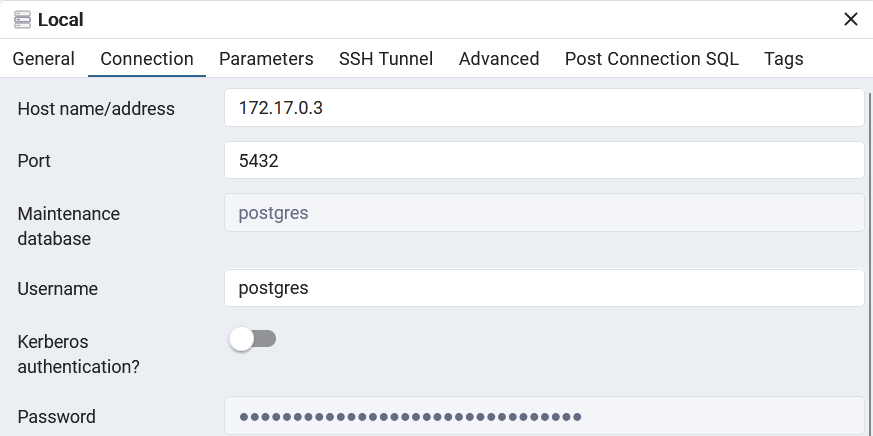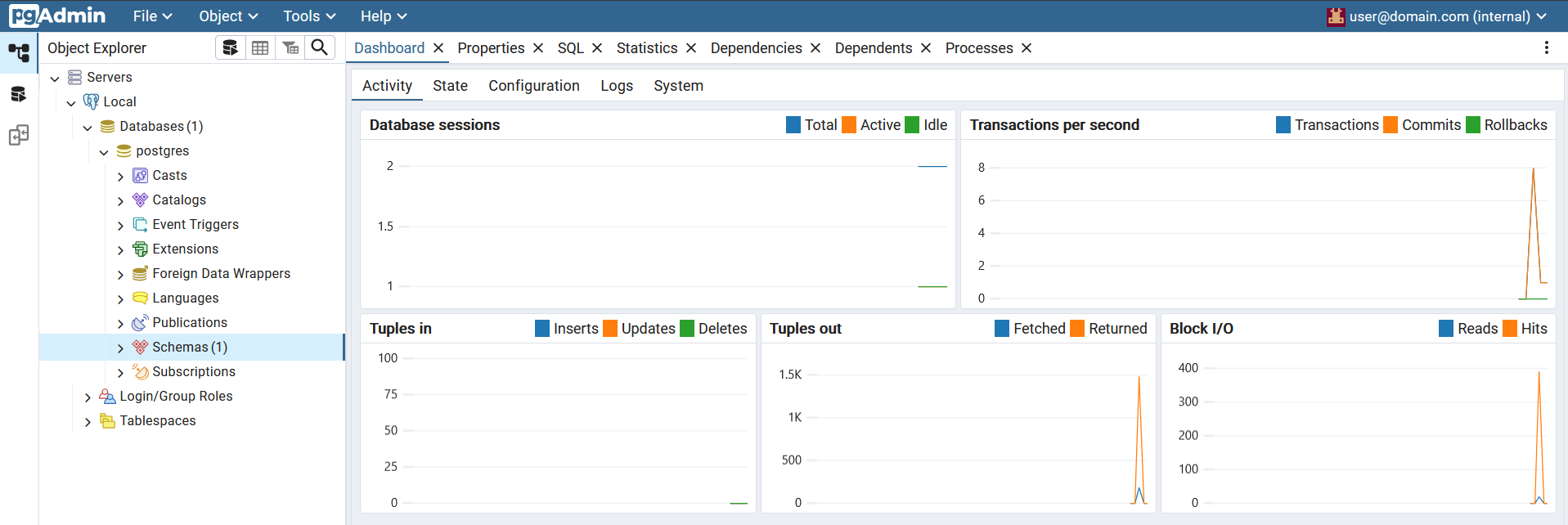PostgreSQL
This page describes my next exercise, of running a single PostgreSQL database for local development. It covers:
- Running PostgreSQL for development in Docker without Kubernetes.
- Running PostgreSQL for development in Docker and Kubernetes, without a load balancer.
- Running PostgreSQL for development in Docker and Kubernetes, with a load balancer.
This is relatively simple to set up and sufficient for local development, but has the limitations of not supporting automatic failovers, backups, or scaling, and it is not suitable for production. To run a PostgreSQL environment in Kubernetes that is suitable for production or to mimic a production environment, I plan to later study how to use one of the available Operators for PostgreSQL, such as:
In this page I will also describe how to use psql and pgAdmin to connect to a
PostgreSQL Server.
Running PostgreSQL in Docker without Kubernetes¶
This information is interesting to compare the differences of running a single PostgreSQL server for local development, with and without Kubernetes.
To run a PostgreSQL 17 server using a volume mount to persist data in the host, run
the following commands, replacing ****** with the desired password:
# create a folder dedicated to persisting postgres
mkdir -p $HOME/stores/postgres
# start a container with PostgreSQL Server
docker run --rm \
--name pg-docker \
-e POSTGRES_PASSWORD=****** \
-d \
-p 5432:5432 \
-v $HOME/docker/volumes/postgres:/var/lib/postgresql/data \
postgres:17
Select the desired password, for POSTGRES_PASSWORD.
The docker command described.
This command runs a PostgreSQL server in a Docker container named pg-docker:
--rm: Automatically removes the container when it stops.--name pg-docker: Names the containerpg-docker.-e POSTGRES_PASSWORD=******: Sets the desired PostgreSQL password.-d: Runs the container in detached (background) mode.-p 5432:5432: Maps port 5432 on the host to port 5432 in the container.-v $HOME/docker/volumes/postgres:/var/lib/postgresql/data: Mounts a host directory for persistent database storage.postgres:17: Uses the official PostgreSQL 17 image.
To verify that the PostgreSQL Server is running, you can inspect the logs of the container with:
One of the log lines should say: database system is ready to accept connections.
Verify that the process is listening.
To verify the process is listening on port 5432, run the following commands:
They should display output like:
Connect using psql¶
Using psql from the host¶
To test a connection to the PostgreSQL database using the psql CLI, let's install the
PostgreSQL client on the host.
To install the client, follow the official PostgreSQL instructions:
sudo apt install curl ca-certificates
sudo install -d /usr/share/postgresql-common/pgdg
sudo curl -o /usr/share/postgresql-common/pgdg/apt.postgresql.org.asc --fail https://www.postgresql.org/media/keys/ACCC4CF8.asc
. /etc/os-release
sudo sh -c "echo 'deb [signed-by=/usr/share/postgresql-common/pgdg/apt.postgresql.org.asc] https://apt.postgresql.org/pub/repos/apt $VERSION_CODENAME-pgdg main' > /etc/apt/sources.list.d/pgdg.list"
sudo apt update
sudo apt -y install postgresql-client-17
Requires extra packages.
Skip this step if you don't want to install extra packages on your Ubuntu host. The
following paragraph describes how to use the psql CLI from a Docker container.
Then, to connect to the PostgreSQL Server running in Docker:
Here we can use localhost because when we started the Docker container, we used the
option -p 5432:5432, which maps port 5432 on the host to port 5432 in the container.
We are using postgres for user name and database name because these are the default
values. If we wanted to use different values when starting the container, we could use
the POSTGRES_USER and POSTGRES_DB env variables when starting the Docker container.
If the connection succeeds, you should enter the psql shell:
You can run the following command in the psql shell to show the connection is working and list all databases:
postgres=# \l
List of databases
Name | Owner | Encoding | Locale Provider | Collate | Ctype | Locale | ICU Rules | Access privileges
-----------+----------+----------+-----------------+------------+------------+--------+-----------+-----------------------
postgres | postgres | UTF8 | libc | en_US.utf8 | en_US.utf8 | | |
template0 | postgres | UTF8 | libc | en_US.utf8 | en_US.utf8 | | | =c/postgres +
| | | | | | | | postgres=CTc/postgres
template1 | postgres | UTF8 | libc | en_US.utf8 | en_US.utf8 | | | =c/postgres +
| | | | | | | | postgres=CTc/postgres
(3 rows)
Using psql from Docker¶
To test a connection using psql within a Docker container, you can run a second
postgres container in interactive mode:
However, in this case we cannot connect to the PostgreSQL server using localhost, as
localhost inside a Docker container does not mean localhost on the host.
To connect to the PostgreSQL database, find the IP address of the running container:
In my case, it displays:
$ docker inspect pg-docker | grep IPAddress
"SecondaryIPAddresses": null,
"IPAddress": "172.17.0.3",
"IPAddress": "172.17.0.3",
To connect to the PostgreSQL Server, use the following command:
root@ade51ee74b3c:/# PGPASSWORD=****** psql -h 172.17.0.3 -p 5432 -U postgres postgres
psql (17.5 (Debian 17.5-1.pgdg120+1))
Type "help" for help.
postgres=#
Connect using pgAdmin¶
pgAdmin is a free and open-source administration and management tool for PostgreSQL databases. It provides a graphical user interface (GUI) for managing PostgreSQL servers, databases, and database objects. pgAdmin is widely used for tasks such as database creation, schema design, data management, and user administration.
To run a container hosting a pgAdmin server, use the following command, replacing
PGADMIN_DEFAULT_PASSWORD with the desired password. The email and password are used on
localhost to sign-in to the pgAdmin GUI.
docker run --rm \
-p 8080:80 \
--name pgadmin \
-e 'PGADMIN_DEFAULT_EMAIL=user@domain.com' \
-e 'PGADMIN_DEFAULT_PASSWORD=******' \
-d \
dpage/pgadmin4
Then, navigate to http://localhost:8080/ to access the local
instance of pgAdmin. It takes several seconds for the pgAdmin server to
become responsive.

To sign-in, use the email and password defined in the command above
(PGADMIN_DEFAULT_EMAIL, PGADMIN_DEFAULT_PASSWORD).
Once logged in, the homepage looks like in the picture below.

To connect to the PostgreSQL Server:
- Open the
Server dialogclicking the right mouse button on Servers in the top left corner of the page, thenRegister > Server…. - Insert the same parameters we used for the
psqlcommand in Docker:postgresfor username and database, and the password used when starting the Docker container for the local environment, and the IP of the Docker container like described above.


Cleaning up¶
Stop the Docker containers. They will be deleted, as they were created using the option
--rm.
Running PostgreSQL in Docker with Kubernetes¶
This time, instead of deleting the last cluster created for the Multi Nodes example, I decided to create a new one named "db".
For now, I will not configure a load balancer to expose the PostgreSQL Server, but
use instead kubectl port-forward
to connect to the service. For this reason, kind.yaml does not include extra port
mappings.
# ./examples/05-single-postgres
kind create cluster --name db --config kind.yaml
kubectl cluster-info --context kind-db
Create a secret for the PostgreSQL admin password, which is referenced by name in the
manifest, replacing mypassword with the desired secret:
Run the deployment that provisions the PostgreSQL Server:
Wait for the pod to become ready:
Inspecting the logs.
Inspect the logs of the container using the commands:
$ kubectl get pods
NAME READY STATUS RESTARTS AGE
postgres-597b764746-xgc6z 1/1 Running 0 27m
$ kubectl logs postgres-597b764746-xgc6z
PostgreSQL Database directory appears to contain a database; Skipping initialization
2025-07-28 08:27:39.831 UTC [1] LOG: starting PostgreSQL 17.5 (Debian 17.5-1.pgdg120+1) on x86_64-pc-linux-gnu, compiled by gcc (Debian 12.2.0-14) 12.2.0, 64-bit
2025-07-28 08:27:39.831 UTC [1] LOG: listening on IPv4 address "0.0.0.0", port 5432
2025-07-28 08:27:39.831 UTC [1] LOG: listening on IPv6 address "::", port 5432
2025-07-28 08:27:39.834 UTC [1] LOG: listening on Unix socket "/var/run/postgresql/.s.PGSQL.5432"
2025-07-28 08:27:39.841 UTC [34] LOG: database system was interrupted; last known up at 2025-07-27 21:01:31 UTC
2025-07-28 08:27:40.074 UTC [34] LOG: database system was not properly shut down; automatic recovery in progress
2025-07-28 08:27:40.077 UTC [34] LOG: redo starts at 0/194BFE0
2025-07-28 08:27:40.077 UTC [34] LOG: invalid record length at 0/194C100: expected at least 24, got 0
2025-07-28 08:27:40.077 UTC [34] LOG: redo done at 0/194C0C8 system usage: CPU: user: 0.00 s, system: 0.00 s, elapsed: 0.00 s
2025-07-28 08:27:40.087 UTC [32] LOG: checkpoint starting: end-of-recovery immediate wait
2025-07-28 08:27:40.098 UTC [32] LOG: checkpoint complete: wrote 3 buffers (0.0%); 0 WAL file(s) added, 0 removed, 0 recycled; write=0.004 s, sync=0.002 s, total=0.015 s; sync files=2, longest=0.001 s, average=0.001 s; distance=0 kB, estimate=0 kB; lsn=0/194C100, redo lsn=0/194C100
2025-07-28 08:27:40.103 UTC [1] LOG: database system is ready to accept connections
To connect to the PostgreSQL Server, we can use kubectl port-forward to create a
tunnel to the service defined in the manifest.
$ PGPASSWORD=****** psql -h localhost -p 5432 -U myuser mydb
psql (17.5 (Ubuntu 17.5-1.pgdg24.04+1))
Type "help" for help.
mydb=#
Issues with extra port mappings.
I also tried configuring extraPortMappings in the Kind node to connect to the
PostgreSQL server, but that doesn't work.
According to GitHub Copilot:
You cannot connect to PostgreSQL using the NodePort address with Kind's extraPortMappings because Kind does not natively support forwarding traffic from the host to service NodePorts inside the cluster without a proper load balancer or additional networking setup.
This is a known limitation: mapping a host port to a container port in Kind only exposes the port on the control-plane node's container, not directly to the Kubernetes service's NodePort. The NodePort is accessible from within the Kind network, but not from your host machine unless you use a load balancer or kubectl port-forward.
Using a Load Balancer¶
Later I wanted to deploy a PostgreSQL Server again, but this time making it accessible
using a Load Balancer instead of using port-forward. To implement the Load Balancer
in Kind, I initially tried using MetalLB, which is a popular tool when working with Kubernetes
outside of cloud environments. According to MetalLB's documentation, load balancers
for bare-metal clusters (without using cloud vendors) in Kubernetes are not
"first class citizens". However, I had issues making MetalLB work with Kind, and I
finally decided to try using the Load Balancer features offered by Kind.
Installing Cloud Provider Kind.
To install Cloud Provider Kind, follow the documentation.
One way is to download one of the released binaries.
Start cloud-provider-kind in a different terminal:
MetalLB and Kind.
I tried using MetalLB with Kind, also following relatively recent tutorials,
but all my attempts failed because of parts that were not working. I finally
gave up and decided to use the Load Balancer features offered by Kind.
I will try using MetalLB again with real nodes, when using Kubeadm to setup a
real Kubernetes cluster.
Delete the db cluster, and recreate it using the kind.yaml file.
# ./examples/05-single-postgres
kind delete cluster --name db
kind create cluster --name db --config kind.yaml
# create postgres
kubectl create secret \
generic \
postgres-secret \
--from-literal=POSTGRES_PASSWORD=mypassword
kubectl apply -f single-postgres-lb.yaml
Wait for the PostgreSQL Service to become available:
Obtain the IP address of the load balancer:
Try connecting using psql:
The connection should work. To connect from a Docker container that is not part
of the Kubernetes cluster, use the --network host
option, and specify to which port the pgAdmin server should listen to:
docker run --rm \
--network host \
-e 'PGADMIN_LISTEN_PORT=8081' \
--name pgadmin \
-e 'PGADMIN_DEFAULT_EMAIL=user@domain.com' \
-e 'PGADMIN_DEFAULT_PASSWORD=******' \
-d \
dpage/pgadmin4
The Kind LoadBalancer IP is only accessible from the host, not from sibling
Docker containers, due to network isolation. That is why --network host is
needed in this case.
Next steps¶
In my next exercise, I will practice with PostgreSQL Operators.